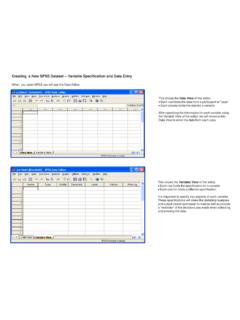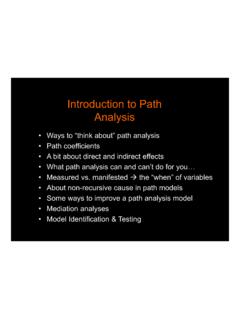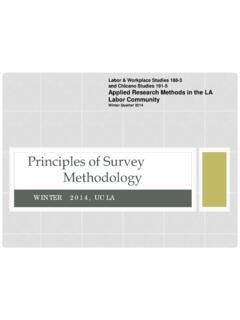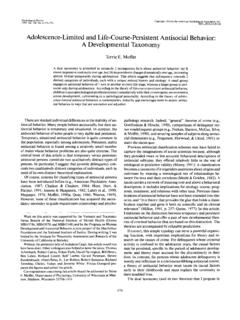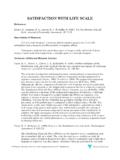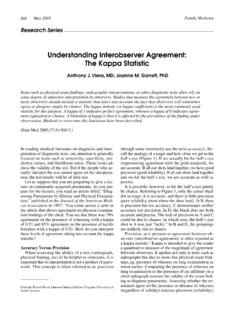Transcription of “Is the test valid?” Criterion-related Validity
1 1 Is the test valid? Jum Nunnally (one of the founders of modern psychometrics) claimed this was silly question ! The point wasn t that tests shouldn t be valid but that a test s Validity must be assessed relative the specific construct(s) it is intended to measure the populationfor which it is intended ( , age, level) the applicationfor which it is intended ( , for classifying folks into categories vs. assigning themquantitative values)So, the real question is, Is this test a valid measure of this construct for this population for this application? That question can be answered! Criterion-related Validity 3 classic types a criterion is the actual value you d like to have but can it hasn t happened yet and you can t wait until it does it s happening now, but you can t measure it like you want It happened in the past and you didn t measure it then does test correlate with criterion ?
2 --has three major typesMeasure the CriterionPast Present FutureMeasure the CriterionMeasure the CriterionPredictive ValidityAdminister testConcurrent ValidityAdminister testAdminister testPostdictiveValidityCriterion-related Validity 3 classic types does test correlate with criterion ? --has three major types predictive --test taken now predicts criterion assessed later most common type of Criterion-related Validity , your GRE score (taken now) predicts how well you will do in grad school (criterion --can t be assessed until later) concurrent --test replaces another assessment (now) often the goal is to substitute a shorter or cheaper test , the written drivers test is a replacement for driving around with an observer until you show you know the rules postdictive --least common type of Criterion-related Validity can I test you now and get a valid score for something that happened earlier , adult memories of childhood feelingsThe advantage of Criterion-related Validity is that it is a relatively simple statistically basedtype of Validity !
3 If the test has the desired correlation with the criterion, then you have sufficient evidence for Criterion-related are, however, some limitations to Criterion-related It is dependent upon your having a criterion Sometimes you don t have a criterion variable to use , first test of construct that is developed It is dependent upon the quality of the criterion variable Sometimes there are limited or competing criteria Correlation is not equivalence your test that is correlatedwith the criterion might also becorrelated with several other variables --what does it measure ? 2 Conducting a predictive Validity Studyexample --test designed to identify qualified front desk personnel for a major hotel chain --200 applicants -and 20 position openingsConducting the proper study give each applicant the test (and seal the results) give each applicants a job working at a front desk assess work performance after 6 months (the criterion) correlate the test (predictor) and work performance (criterion)Anybody see why the chain might not be willing to apply this design?
4 Here are two designs often substituted for this proper concurrent Validity for predictive Validity assess work performance of all folks currently doing the job give them each the test correlate the test (predictor) and work performance (criterion)Problems? Not working with the population of interest (applicants) Range restriction --work performance and test score variability are restricted by this approach current hiring practice probably not random good workers move up --poor ones move out Range restriction will artificially lower the Validity coefficient (r) Applicant pool --target populationSelected (hired) folks assuming selection basis is somewhat reasonable/functionalSample used in concurrent Validity study worst of those hired have been released best of those hired have changed jobs What happens to the sample.
5 Criterion -job performancePredictor --interview/measureWhat happens to the Validity coefficient --rApplicant poolr = .75 Sample used in Validity studyr = .20 Hired Folks3 Using and testing predictive Validity simultaneously give each applicant the test give those applicants who score well a front desk job assess work performance after 6 months (the criterion) correlate the test (predictor) and work performance (criterion)Problems? Not working with the population of interest (all applicants) Range restriction --work performance and test score variability are restricted by this approach only hired good those with better scores on the test (probably) hired those with better work performance Range restriction will artificially lower the Validity coefficient (r) Using a test before its validated can have legal ramifications Thinking about the procedures used to assess criterion related the types of criterion related Validity involved correlatingthe new measure/instrument with some selected criterion large correlations indicate criterion related Validity (.)
6 Smaller correlations are interpreted to indicate the limited Validity of the insrument(As mentioned before)This approach assumes you have a criterion that really is a gold standard of what you want to measure. Even when such a measure exists it will itself probably have limited Validity and reliability We will consider each of these and how they limit the conclusions we can draw about the criterion related Validity of our instrument from correlational analysesLet s consider the impact of limited Validity of the criterionupon the assessment of the criterion related validityof the new instrument/measure let s assume we have a perfect measure of the construct if the criterionwe plan to use to validate our new measure is really good it might itself have a Validity as high as, say.
7 8 --shares 64% of its variability with perfect measure here are two hypothetical new measures -which is more valid? Measure 1 --r with criterion = .70 (49% overlap) Measure 2--r with criterion = .50 (25% overlap)Measure 1 has the higher Validity coefficient, but the weaker relationship with the perfect measureMeasure 2 has the stronger relationship with the perfect measure, but looks bad because of the choice of criterionSo, the meaningfulness of a Validity coefficient is dependent upon the quality of the criterion used for assessmentBest case scenario .. criterion is objective measure of the specific behavior of interest when the measure IS the behavior we are interested in, not some representation , graduate school GPA, hourly sales, # publicationsTougher situation.
8 Objective measure of behavior represents construct of interest, but isn t the specific behavior of interest , preparation for the professorate, sales skill, contribution to the department notice each of the measures above is an incomplete representation of the construct listed hereHorror show .. subjective (potentially biased) rating of behavior or performance advisor s eval, floor manager s eval, Chair s evaluations4 Local ValidityExplicit check on Validity of the test for your population and application. Sounds good, but likely to have the following problems Sample size will be small (limited to your subject pool ) Study will likely be run by semi-pros Optimal designs probably won t be used ( , predictive Validity ) Often (not always) this is an attempt to bend the use of an established test to a population/application for which it was not designed nor previously validated Other kinds of Criterion-related ValidityAsks if the test improves on the Criterion-related Validity of whatever tests are currently being I claim that scores from my new structured interview will lead to more accurate selection of graduate students.
9 I m not suggesting you stop using what you are using, but rather that you ADD my Incremental Validity requires we show that the new test + old tests do better than old tests alone . R grad. grea, grev, greq= .45R grad. Grea, grev, greq, interview= .62 Incremental Validity is .17 (or 38% increase)Experimental ValidityA study designed to show that the test reacts as it should to a specific the usual experiment, we have confidence that the DV measures the construct in which we are interested, and we are testing if the IV is related to that DV (that we trust).In Experimental Validity , we have confidence in the IV (treatment) and want to know if the DV (the test being validated) will respond as it should to this treatment.
10 Example: I have this new index of social anxiety I know that aparticular cognitive-behavioral treatment has a long, successful history of treating social anxiety. My experimental Validity study involves pre-and post-testing 50 participants who receive this treatment --experimental Criterion-related Validity would be demonstrated by a pre-post score difference (in the right direction)Now let s consider the relationshipbetween reliability & reliability is a precursor for Validity conceptually--how can a measure be consistently accurate(valid), unless it is consistent?? internal consistency --all items reflect the same construct test-retest consistency --scale yields repeatable scores statistically--limited reliability means that some of the variability in the measure is systematic, but part isunsystematic (unreliable) low reliability will attenuate the Validity correlation much like range restriction --but this is a restriction of the systematic variance , not the overall varianceit is possible to statistically correct for this attenuation--like all statistical correction , this must be carefully applied!



